2013 NISSAN GT-R engine
[x] Cancel search: enginePage 17 of 346
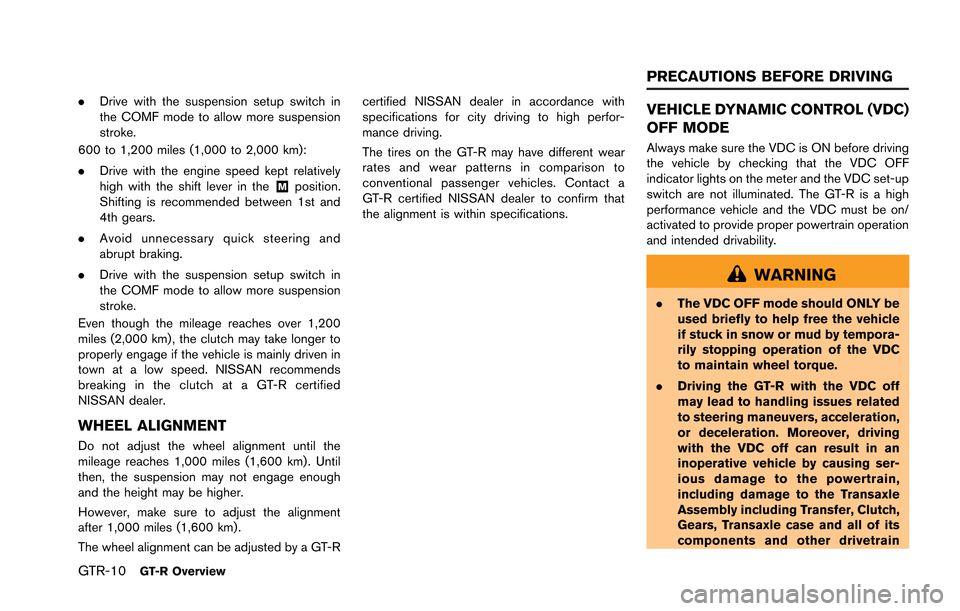
GTR-10GT-R Overview
.Drive with the suspension setup switch in
the COMF mode to allow more suspension
stroke.
600 to 1,200 miles (1,000 to 2,000 km):
. Drive with the engine speed kept relatively
high with the shift lever in the
&Mposition.
Shifting is recommended between 1st and
4th gears.
. Avoid unnecessary quick steering and
abrupt braking.
. Drive with the suspension setup switch in
the COMF mode to allow more suspension
stroke.
Even though the mileage reaches over 1,200
miles (2,000 km) , the clutch may take longer to
properly engage if the vehicle is mainly driven in
town at a low speed. NISSAN recommends
breaking in the clutch at a GT-R certified
NISSAN dealer.
WHEEL ALIGNMENT
Do not adjust the wheel alignment until the
mileage reaches 1,000 miles (1,600 km). Until
then, the suspension may not engage enough
and the height may be higher.
However, make sure to adjust the alignment
after 1,000 miles (1,600 km) .
The wheel alignment can be adjusted by a GT-R certified NISSAN dealer in accordance with
specifications for city driving to high perfor-
mance driving.
The tires on the GT-R may have different wear
rates and wear patterns in comparison to
conventional passenger vehicles. Contact a
GT-R certified NISSAN dealer to confirm that
the alignment is within specifications.
VEHICLE DYNAMIC CONTROL (VDC)
OFF MODE
Always make sure the VDC is ON before driving
the vehicle by checking that the VDC OFF
indicator lights on the meter and the VDC set-up
switch are not illuminated. The GT-R is a high
performance vehicle and the VDC must be on/
activated to provide proper powertrain operation
and intended drivability.
WARNING
.
The VDC OFF mode should ONLY be
used briefly to help free the vehicle
if stuck in snow or mud by tempora-
rily stopping operation of the VDC
to maintain wheel torque.
. Driving the GT-R with the VDC off
may lead to handling issues related
to steering maneuvers, acceleration,
or deceleration. Moreover, driving
with the VDC off can result in an
inoperative vehicle by causing ser-
ious damage to the powertrain,
including damage to the Transaxle
Assembly including Transfer, Clutch,
Gears, Transaxle case and all of its
components and other drivetrain
PRECAUTIONS BEFORE DRIVING
Page 18 of 346
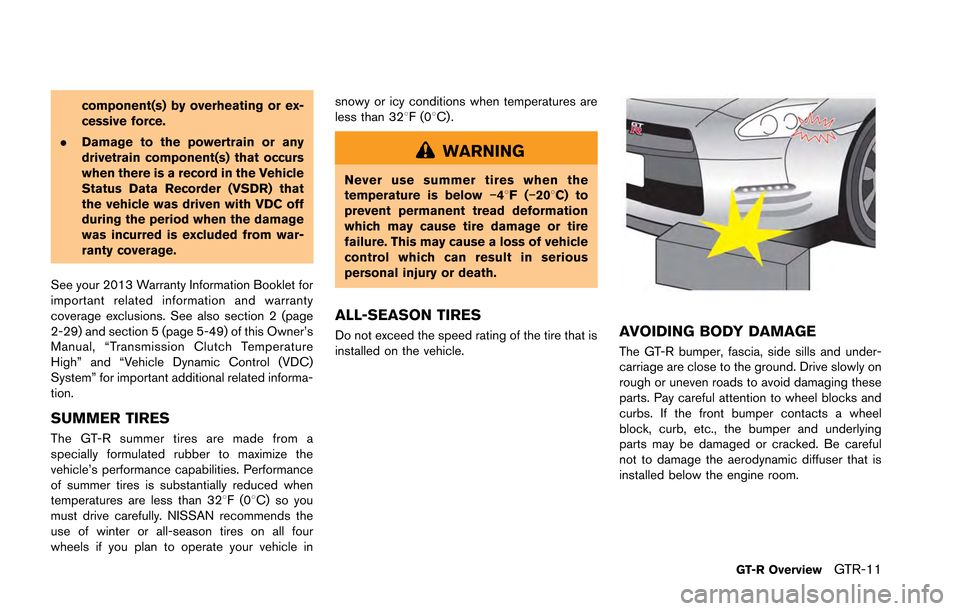
component(s) by overheating or ex-
cessive force.
. Damage to the powertrain or any
drivetrain component(s) that occurs
when there is a record in the Vehicle
Status Data Recorder (VSDR) that
the vehicle was driven with VDC off
during the period when the damage
was incurred is excluded from war-
ranty coverage.
See your 2013 Warranty Information Booklet for
important related information and warranty
coverage exclusions. See also section 2 (page
2-29) and section 5 (page 5-49) of this Owner’s
Manual, “Transmission Clutch Temperature
High” and “Vehicle Dynamic Control (VDC)
System” for important additional related informa-
tion.
SUMMER TIRES
The GT-R summer tires are made from a
specially formulated rubber to maximize the
vehicle’s performance capabilities. Performance
of summer tires is substantially reduced when
temperatures are less than 328F(0 8C) so you
must drive carefully. NISSAN recommends the
use of winter or all-season tires on all four
wheels if you plan to operate your vehicle in snowy or icy conditions when temperatures are
less than 328F(0
8C) .
WARNING
Never use summer tires when the
temperature is below −48F(−208C) to
prevent permanent tread deformation
which may cause tire damage or tire
failure. This may cause a loss of vehicle
control which can result in serious
personal injury or death.
ALL-SEASON TIRES
Do not exceed the speed rating of the tire that is
installed on the vehicle.AVOIDING BODY DAMAGE
The GT-R bumper, fascia, side sills and under-
carriage are close to the ground. Drive slowly on
rough or uneven roads to avoid damaging these
parts. Pay careful attention to wheel blocks and
curbs. If the front bumper contacts a wheel
block, curb, etc., the bumper and underlying
parts may be damaged or cracked. Be careful
not to damage the aerodynamic diffuser that is
installed below the engine room.
GT-R OverviewGTR-11
Page 19 of 346
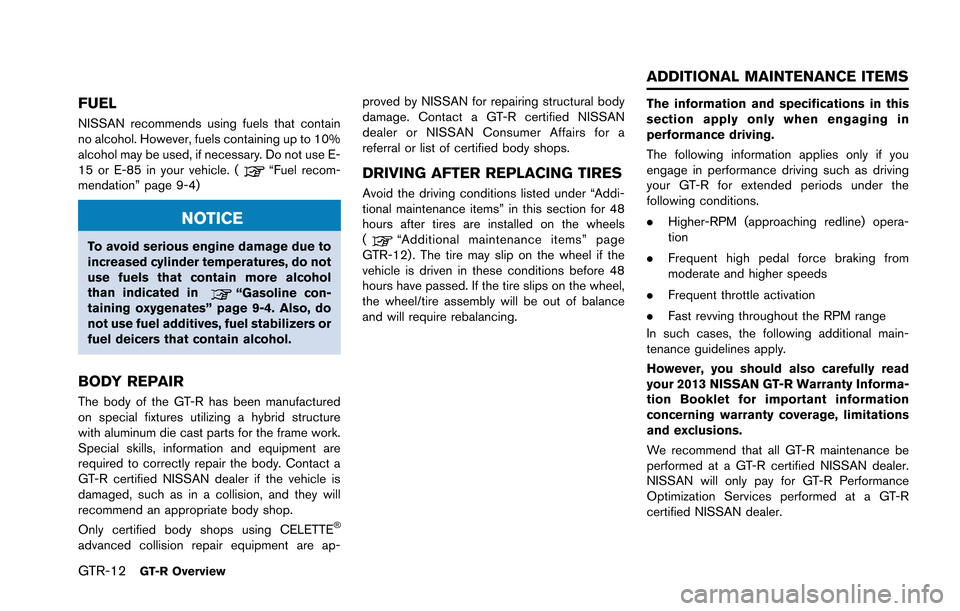
GTR-12GT-R Overview
FUEL
NISSAN recommends using fuels that contain
no alcohol. However, fuels containing up to 10%
alcohol may be used, if necessary. Do not use E-
15 or E-85 in your vehicle. (
“Fuel recom-
mendation” page 9-4)
NOTICE
To avoid serious engine damage due to
increased cylinder temperatures, do not
use fuels that contain more alcohol
than indicated in
“Gasoline con-
taining oxygenates” page 9-4. Also, do
not use fuel additives, fuel stabilizers or
fuel deicers that contain alcohol.
BODY REPAIR
The body of the GT-R has been manufactured
on special fixtures utilizing a hybrid structure
with aluminum die cast parts for the frame work.
Special skills, information and equipment are
required to correctly repair the body. Contact a
GT-R certified NISSAN dealer if the vehicle is
damaged, such as in a collision, and they will
recommend an appropriate body shop.
Only certified body shops using CELETTE
®
advanced collision repair equipment are ap- proved by NISSAN for repairing structural body
damage. Contact a GT-R certified NISSAN
dealer or NISSAN Consumer Affairs for a
referral or list of certified body shops.
DRIVING AFTER REPLACING TIRES
Avoid the driving conditions listed under “Addi-
tional maintenance items” in this section for 48
hours after tires are installed on the wheels
(
“Additional maintenance items” page
GTR-12) . The tire may slip on the wheel if the
vehicle is driven in these conditions before 48
hours have passed. If the tire slips on the wheel,
the wheel/tire assembly will be out of balance
and will require rebalancing.
The information and specifications in this
section apply only when engaging in
performance driving.
The following information applies only if you
engage in performance driving such as driving
your GT-R for extended periods under the
following conditions.
. Higher-RPM (approaching redline) opera-
tion
. Frequent high pedal force braking from
moderate and higher speeds
. Frequent throttle activation
. Fast revving throughout the RPM range
In such cases, the following additional main-
tenance guidelines apply.
However, you should also carefully read
your 2013 NISSAN GT-R Warranty Informa-
tion Booklet for important information
concerning warranty coverage, limitations
and exclusions.
We recommend that all GT-R maintenance be
performed at a GT-R certified NISSAN dealer.
NISSAN will only pay for GT-R Performance
Optimization Services performed at a GT-R
certified NISSAN dealer.
ADDITIONAL MAINTENANCE ITEMS
Page 20 of 346

PRECAUTIONS ON PERFORMANCE
DRIVING
The information and specifications in this
section apply only when engaging in
performance driving.
Checking the temperature of the
coolant and oils on the multi func-
tion display
When the temperatures of the engine coolant
and oil, and the oil pressure exceed the normal
range, the color of the meter on the multi
function display changes to red to warn the
driver. When engaging in high performance
driving, switch the display to the function meter
to display the temperature of the engine coolant
and oil, and the oil pressure. When the color of
the meter display changes to red, perform cool
down driving. When the values of the tempera-
ture and pressure return to the normal range, the
color of the meter display will turn back to white.
Warning temperature:
.Engine coolant temperature is 2308 F
(1108C) or higher:
If the engine coolant temperature increases
above 2308F (1108C) , the color of the meter
display on the multi function display changes
to red to warn of a possible overheat condition and engine output is reduced.
. Engine oil temperature is 2758F (1358C) or
higher:
If the engine oil temperature is higher than
2758F (1358C), the meter display changes
to red, maximum engine speed is automati-
cally limited to 4,000 rpm, and the transmis-
sion automatically changes from the
&Mposition to the&Aposition.
. Transmission oil temperature is 2848 F
(1408C) or higher:
If the transmission oil temperature increases
to over 2848F (1408C) , the color of the
meter display changes to red. However, the
vehicle can continue to be driven until the
temperature reaches 2958F (1468C) . If the
oil temperature exceeds 2848 F (1408C)
while driving (the color of the meter dis-
played in red) , change both the transmission
oil and the differential oil after driving
because these fluids have deteriorated
because of the heat.
Cool down
The information and specifications in this
section apply only when engaging in
performance driving.
Cool down the vehicle to help extend the life of the vehicle if coolant temperatures are extremely
high. Drive the vehicle at 37 to 50 MPH (60 to
80 km/h), in 5th or 6th gear for 2 to 3 miles (3 to
5 km) and then stop the engine.
Refueling precautions
WARNING
Do not attempt to top off the fuel tank
after the fuel pump nozzle shuts off
automatically. Continued refueling may
cause fuel overflow, resulting in fuel
spray and possibly a fire. The fuel tank
is full at the first automatic shutoff.
To maximize vehicle performance, the fuel tank is
located as low as possible to lower the vehicle
center of gravity. The tank is also divided into
two parts. This fuel tank design causes higher
pressures inside the tank than other vehicles so
fuel spillage is possible by trying to top off the
fuel tank after automatic shutoff.
The fuel tank pressure is higher when the vehicle
is hot, especially if the tank is more than half full.
If the cap is opened when the vehicle is hot, it
may cause fuel spray and there may be a hissing
noise. Open the cap slowly, releasing the
pressure from the tank gradually. Also, if the
GT-R OverviewGTR-13
Page 21 of 346
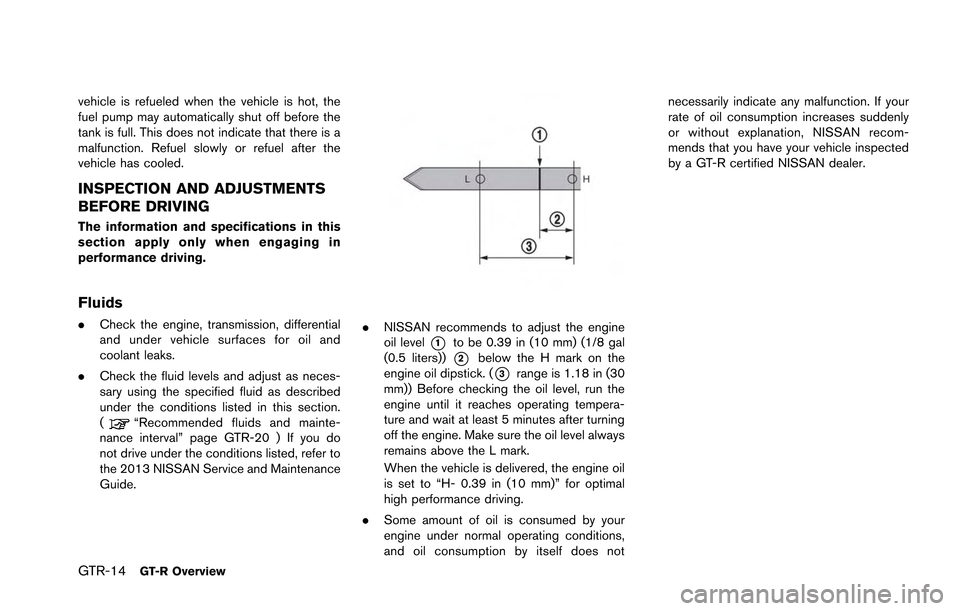
GTR-14GT-R Overview
vehicle is refueled when the vehicle is hot, the
fuel pump may automatically shut off before the
tank is full. This does not indicate that there is a
malfunction. Refuel slowly or refuel after the
vehicle has cooled.
INSPECTION AND ADJUSTMENTS
BEFORE DRIVING
The information and specifications in this
section apply only when engaging in
performance driving.
Fluids
.Check the engine, transmission, differential
and under vehicle surfaces for oil and
coolant leaks.
. Check the fluid levels and adjust as neces-
sary using the specified fluid as described
under the conditions listed in this section.
(
“Recommended fluids and mainte-
nance interval” page GTR-20 ) If you do
not drive under the conditions listed, refer to
the 2013 NISSAN Service and Maintenance
Guide.
. NISSAN recommends to adjust the engine
oil level
*1to be 0.39 in (10 mm) (1/8 gal
(0.5 liters))
*2below the H mark on the
engine oil dipstick. (
*3range is 1.18 in (30
mm)) Before checking the oil level, run the
engine until it reaches operating tempera-
ture and wait at least 5 minutes after turning
off the engine. Make sure the oil level always
remains above the L mark.
When the vehicle is delivered, the engine oil
is set to “H- 0.39 in (10 mm)” for optimal
high performance driving.
. Some amount of oil is consumed by your
engine under normal operating conditions,
and oil consumption by itself does not necessarily indicate any malfunction. If your
rate of oil consumption increases suddenly
or without explanation, NISSAN recom-
mends that you have your vehicle inspected
by a GT-R certified NISSAN dealer.
Page 22 of 346
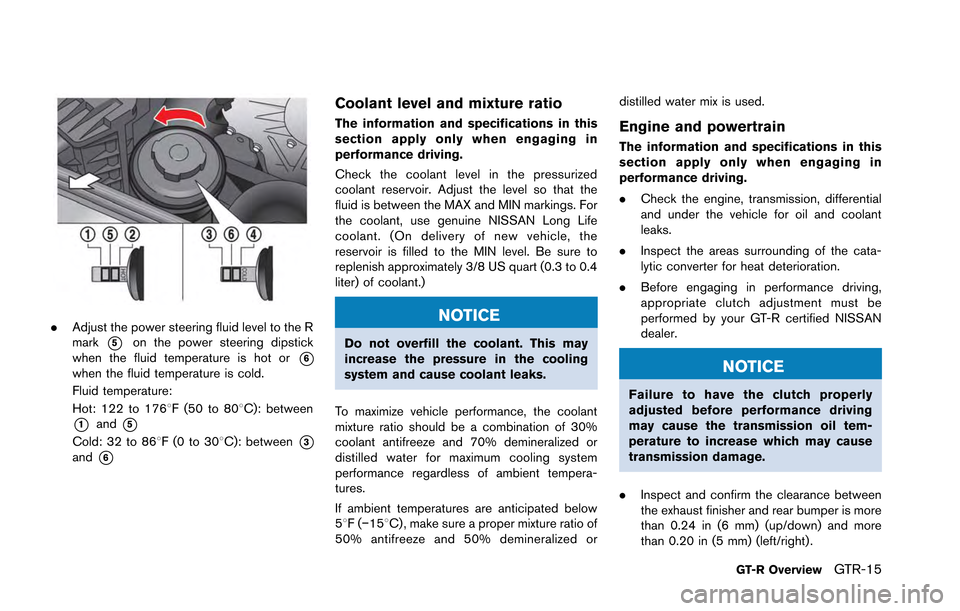
.Adjust the power steering fluid level to the R
mark
*5on the power steering dipstick
when the fluid temperature is hot or
*6when the fluid temperature is cold.
Fluid temperature:
Hot: 122 to 1768F (50 to 808C): between
*1and*5
Cold: 32 to 868F(0to30 8C): between*3and*6
Coolant level and mixture ratio
The information and specifications in this
section apply only when engaging in
performance driving.
Check the coolant level in the pressurized
coolant reservoir. Adjust the level so that the
fluid is between the MAX and MIN markings. For
the coolant, use genuine NISSAN Long Life
coolant. (On delivery of new vehicle, the
reservoir is filled to the MIN level. Be sure to
replenish approximately 3/8 US quart (0.3 to 0.4
liter) of coolant.)
NOTICE
Do not overfill the coolant. This may
increase the pressure in the cooling
system and cause coolant leaks.
To maximize vehicle performance, the coolant
mixture ratio should be a combination of 30%
coolant antifreeze and 70% demineralized or
distilled water for maximum cooling system
performance regardless of ambient tempera-
tures.
If ambient temperatures are anticipated below
58F( −158C) , make sure a proper mixture ratio of
50% antifreeze and 50% demineralized or distilled water mix is used.
Engine and powertrain
The information and specifications in this
section apply only when engaging in
performance driving.
.
Check the engine, transmission, differential
and under the vehicle for oil and coolant
leaks.
. Inspect the areas surrounding of the cata-
lytic converter for heat deterioration.
. Before engaging in performance driving,
appropriate clutch adjustment must be
performed by your GT-R certified NISSAN
dealer.
NOTICE
Failure to have the clutch properly
adjusted before performance driving
may cause the transmission oil tem-
perature to increase which may cause
transmission damage.
. Inspect and confirm the clearance between
the exhaust finisher and rear bumper is more
than 0.24 in (6 mm) (up/down) and more
than 0.20 in (5 mm) (left/right) .
GT-R OverviewGTR-15
Page 26 of 346

the wheels. The tire may slip on the wheel if
the vehicle is driven in these conditions
before 48 hours have passed. If the tire slips
on the wheel, the wheel/tire assembly will be
out of balance and will require rebalancing.
Brakes
The information and specifications in this
section apply only when engaging in
performance driving.
.Check for the heat deterioration of the
brakes and parts around the brakes.
. It is recommended that you remove air from
the brake system after any of the following:
— When engaging in high performance
driving for the first time after purchasing
a new vehicle.
— After replacing the brake fluid.
— When engaging in high performance driving for a sustained period of time. It
is recommended that bleeding the brake
be performed when the brake calipers
are hot (about 2128F (1008C)) .
Brake pad:
NISSAN recommends adding an additional
cross spring to the front calipers before enga-
ging in performance driving. The additional
spring reduces brake pad movement resulting from cornering forces and will reduce the stroke
of the brake pedal. Contact a GT-R certified
NISSAN dealer to purchase the spring and
arrange installation. If a cross spring is added, a
clattering or squeaking sound may be heard on
rare occasions.
Brake pad break-in procedure:
NISSAN recommends that a special brake pad
break-in procedure be performed before enga-
ging in performance driving. Contact a GT-R
certified NISSAN dealer for details.
INSPECTION AND ADJUSTMENTS
AFTER DRIVING
The information and specifications in this
section apply only when engaging in
performance driving.
NOTICE
At the completion of performance driv-
ing, all fluid and other adjustments
should be returned to the normal fluid
specifications as shown in the “Main-
tenance and do-it-yourself” section of
this manual.
Fluids
The information and specifications in this
section apply only when engaging in
performance driving.
.
Check the engine, transmission, differential
and under the vehicle for oil and coolant
leaks.
. Check the fluid levels and adjust as neces-
sary using the specified fluid as described
under the conditions listed in this section.
(
“Recommended fluids and mainte-
nance interval” page GTR-20) If you do not
drive under the conditions listed, refer to the
2013 NISSAN Service and Maintenance
Guide.
. When changing fluids, be sure to use the
specified fluids as described in this Owner’s
manual. (
“Capacities and recom-
mended fuel/lubricants” page 9-2)
GT-R OverviewGTR-19
Page 27 of 346
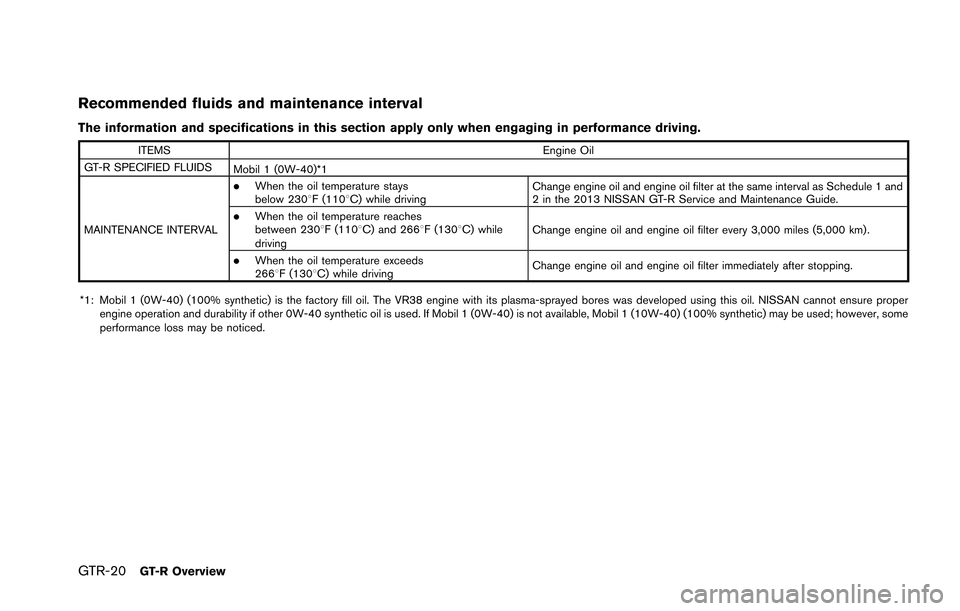
GTR-20GT-R Overview
Recommended fluids and maintenance interval
The information and specifications in this section apply only when engaging in performance driving.
ITEMSEngine Oil
GT-R SPECIFIED FLUIDS Mobil 1 (0W-40)*1
MAINTENANCE INTERVAL
.When the oil temperature stays
below 2308F (1108C) while driving Change engine oil and engine oil filter at the same interval as Schedule 1 and
2 in the 2013 NISSAN GT-R Service and Maintenance Guide.
.When the oil temperature reaches
between 2308F (1108C) and 2668F (1308C) while
drivingChange engine oil and engine oil filter every 3,000 miles (5,000 km).
.When the oil temperature exceeds
2668F (1308C) while driving
Change engine oil and engine oil filter immediately after stopping.
*1: Mobil 1 (0W-40) (100% synthetic) is the factory fill oil. The VR38 engine with its plasma-sprayed bores was developed using this oil. NISSAN cannot ensure proper engine operation and durability if other 0W-40 synthetic oil is used. If Mobil 1 (0W-40) is not available, Mobil 1 (10W-40) (100% synthetic) may be used; however, some
performance loss may be noticed.